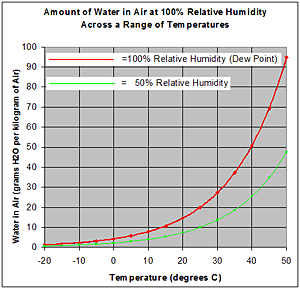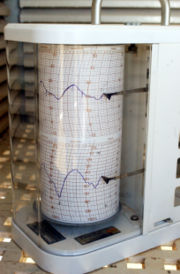Humidity Explained |
Absolute Humidity
Definition: Absolute humidity is the quantity of water in a particular volume of air. The most common units are grams per cubic meter, although any mass unit and any volume unit could be used. Pounds per cubic foot is common in the U.S., and occasionally even other units mixing the English and Metric systems are used.
 If all the water in one cubic meter of air were condensed into a container, the container could be weighed to determine absolute humidity. The
amount of vapor in that cube of air is the absolute humidity of that cubic meter of air. More technically: the mass of water vapor mw, per cubic
meter of air, Va.
If all the water in one cubic meter of air were condensed into a container, the container could be weighed to determine absolute humidity. The
amount of vapor in that cube of air is the absolute humidity of that cubic meter of air. More technically: the mass of water vapor mw, per cubic
meter of air, Va.
Absolute humidity ranges from 0 grams per cubic meter in dry air to 30 grams per cubic meter (0.03 ounce per cubic foot) when the vapour is saturated at 30° C.
The absolute humidity changes as air pressure changes. This is very inconvenient for chemical engineering calculations, e.g. for dryers, where temperature can vary considerably. As a result, absolute humidity is generally defined in chemical engineering as mass of water vapor per unit mass of dry air, also known as the mass mixing ratio, which is much more rigorous for heat and mass balance calculations. Mass of water per unit volume as in the equation above would then be defined as volumetric humidity. Because of the potential confusion, British Standard BS 1339 (revised 2002) suggests avoiding the term "absolute humidity". Units should always be carefully checked. Most humidity charts are given in g/kg or kg/kg, but any mass units may be used.
Mixing Ratio or Humidity Ratio
Mixing or humidity ratio is expressed as a ratio of kilograms of water vapor, mw, per kilogram of dry air, md, at a given pressure. The colloquial term Moisture Content is also used instead of Mixing/Humidity Ratio. Humidity Ratio is a standard axis on psychrometric charts, and is a useful parameter in psychrometrics calculations because it does not change with temperature except when the air cools below dewpoint.
Partial pressure of water vapor and air can also be used to express the ratio.
Relative Humidity
Relative humidity is defined as the ratio of the partial pressure of water vapor in a gaseous mixture of air and water vapor to the saturated vapor pressure of water at a given temperature. Relative humidity is expressed as a percentage. Relative humidity is often mentioned in weather forecasts and reports, as it is an indicator of the likelihood of precipitation, dew or fog. In hot summer weather, it also increases the apparent temperature to humans (and other animals) by hindering the evaporation of perspiration from the skin as the relative humidity rises.
Specific Humidity
Specific humidity is the ratio of water vapor to air (including water vapor and dry air) in a particular volume. Specific humidity ratio is expressed as a ratio of kilograms of water vapor, mw, per kilogram of mixture, mt.
Humidity During Rain
Humidity is a measure of the amount of water vapor dissolved in the air, not including any liquid water or ice falling through the air. For clouds to form, and rain to start, the air does have to reach 100% relative humidity, but only where the clouds are forming or where the rain is falling from. This normally happens when the air rises and cools. Typically, rain falls into air with less than saturated humidity. Some water from the rain may evaporate into the air as it falls, increasing the humidity, but not necessarily enough to raise the humidity to 100%. It is even possible for rain falling through warm, humid air to be cold enough to lower the air temperature to the dew point, thus condensing water vapor out of the air. Although that would indeed raise the relative humidity to 100%, the water lost from the air (as dew) would also lower the absolute humidity.
Dew Point and Frost Point
Associated with relative humidity is dew point (If the dew point is below freezing, it is referred to as the frost point). Dew point is the temperature at which water vapor saturates from an air mass into liquid or solid usually forming rain, snow, frost, or dew. Dew point normally occurs when a mass of air has a relative humidity of 100%. This happens in the atmosphere as a result of cooling through a number of different processes.
Measuring and Regulating Humidity
 A hygrometer is a device used for measuring the humidity of the airThere are various devices used to measure and regulate humidity. A device used
to measure humidity is called a psychrometer or hygrometer. A humidistat is used to regulate the humidity of a building with a de-humidifier.
These can be analogous to a thermometer and thermostat for temperature control.
A hygrometer is a device used for measuring the humidity of the airThere are various devices used to measure and regulate humidity. A device used
to measure humidity is called a psychrometer or hygrometer. A humidistat is used to regulate the humidity of a building with a de-humidifier.
These can be analogous to a thermometer and thermostat for temperature control.
Humidity is also measured on a global scale using remotely placed satellites. These satellites are able to detect the concentration of water in the troposphere at altitudes between 4 and 12 kilometers. Satellites that can measure water vapor have sensors that are sensitive to infrared radiation. Water vapor specifically absorbs and re-radiates radiation in this spectral band. Satellite water vapor imagery plays an important role in monitoring climate conditions (like the formation of thunderstorms) and in the development of future weather forecasts.
Humidity and Air Density
Humid air is less dense than dry air because a molecule of water is less dense than molecules of nitrogen and oxygen. Isaac Newton discovered this phenomenon and wrote about it in his book Opticks. Avogadro's ideal gas law states that a fixed volume of gas at a given temperature and pressure always contains the same number of molecules regardless of what type of gas it is. Consider a cubic meter of dry air. About 78% of the molecules are nitrogen (N2), with a molecular weight of 28. Another 21% of the molecules are oxygen (O2), with a molecular weight of 32. The final 1% is a mixture of other gases.
Effects on Human Body
The human body sheds heat by a combination of evaporation of perspiration, heat convection in the surrounding air, and thermal radiation. Under conditions of high humidity, the evaporation of sweat from the skin is decreased and the body's efforts to maintain an acceptable body temperature may be significantly impaired. Also, if the atmosphere is as warm as or warmer than the skin during times of high humidity, blood brought to the body surface cannot shed heat by conduction to the air, and a condition called hyperpyrexia results. With so much blood going to the external surface of the body, relatively less goes to the active muscles, the brain, and other internal organs. Physical strength declines and fatigue occurs sooner than it would otherwise. Alertness and mental capacity also may be affected. This resulting condition is called heat stroke or hyperthermia.
Recommendations for Comfort
Humans control their body temperature by sweating and shivering. The United States Environmental Protection Agency cites the ASHRAE Standard 55-1992 Thermal Environmental Conditions for Human Occupancy, which recommends keeping relative humidity between 30% and 60%, with below 50% preferred to control dust mites. At high humidity sweating is less effective so we feel hotter; thus the desire to remove humidity from air with air conditioning in the summer. In the winter, heating cold outdoor air can decrease indoor relative humidity levels to below 30%, leading to discomfort such as dry skin and excessive thirst.
Effects on Electronics
Many electronic devices have humidity specifications, for example, 5 to 95%. At the top end of the range, moisture may increase the conductivity of permeable insulators leading to malfunction. Too low humidity may make materials brittle. A particular danger to electronic items, regardless of the stated operating humidity range, is condensation. When an electronic item is moved from a cold place (eg garage, car, shed, an air-conditioned space in the tropics) to a warm humid place (house, outside tropics), condensation may coat circuit boards and other insulators, leading to short circuit inside the equipment. Such short circuits may cause substantial permanent damage if the equipment is powered on before the condensation has evaporated. A similar condensation effect can often be observed when a person wearing glasses comes in from the cold. It is advisable to allow electronic equipment to acclimatise for several hours, after being brought in from the cold, before powering on. The inverse is also true.
Excessively high humidity causes corrosion in electronics. Low humidity favors buildup of static electricity, which may result in spontaneous shutdown of servers in data centres. Apart from spurious erratic function, electrostatic discharges can cause dielectric breakdown in solid state devices, resulting in irreversible damage. Therefore humidity is an important measure in the control of electronic production or data centre facilities.
Most Humid Places on Earth
The most humid cities on earth are generally located closer to the equator, near coastal regions. Cities in South and Southeast Asia seem to be among the most humid. Kolkata, India, Kerala, Manila, Philippines and Bangkok, Thailand. Thailand and Philippines experience extreme humidity during their rainy seasons combined with warmth giving the feel of a lukewarm Sauna. Darwin, Australia experiences an extremely humid wet season from December to April. Kuala Lumpur and Singapore have very high humidity all year round because of their proximity to water bodies and the Equator and overcast weather; despite sunshine, perfectly clear days are rare in these locations and it is often misty. In cooler places such as Northern Tasmania, Australia, high humidity is experienced all year due to the ocean between mainland Australia and Tasmania. In the summer the hot dry air is absorbed by this ocean and the temperature rarely climbs above 86° F (30° C).
In the United States the most humid cities, strictly in terms of relative humidity, are Forks and Olympia, Washington. This fact may come as a surprise to many, as the climate in this region rarely exhibits the discomfort usually associated with high humidity. Dew points are typically much lower on the West Coast than on the East. Because high dew points play a more significant role than relative humidity in the discomfort created during humid days, the air in these western cities usually does not feel "humid."
The highest dew points are found in coastal Florida and Texas. When comparing Key West and Houston, two of the most humid cities from those states, coastal Florida seems to have the higher dew points on average. But, as noted by Jack Williams of USA Today, Houston lacks the coastal breeze present in Key West.
The US city with the lowest annual humidity is Yuma, Arizona, averaging under 50% for a high and 22% as a low. The next-lowest humidity is Tucson, Arizona, average high humidity of 57% and a low of 26%. Lowest in the world is Antarctica.
By clicking HERE you can view the average USA States, Islands & Territories Average Relative Humidity (%) - Morning & Afternoon readings for the last 50 years.
Definition: Absolute humidity is the quantity of water in a particular volume of air. The most common units are grams per cubic meter, although any mass unit and any volume unit could be used. Pounds per cubic foot is common in the U.S., and occasionally even other units mixing the English and Metric systems are used.
 If all the water in one cubic meter of air were condensed into a container, the container could be weighed to determine absolute humidity. The
amount of vapor in that cube of air is the absolute humidity of that cubic meter of air. More technically: the mass of water vapor mw, per cubic
meter of air, Va.
If all the water in one cubic meter of air were condensed into a container, the container could be weighed to determine absolute humidity. The
amount of vapor in that cube of air is the absolute humidity of that cubic meter of air. More technically: the mass of water vapor mw, per cubic
meter of air, Va.Absolute humidity ranges from 0 grams per cubic meter in dry air to 30 grams per cubic meter (0.03 ounce per cubic foot) when the vapour is saturated at 30° C.
The absolute humidity changes as air pressure changes. This is very inconvenient for chemical engineering calculations, e.g. for dryers, where temperature can vary considerably. As a result, absolute humidity is generally defined in chemical engineering as mass of water vapor per unit mass of dry air, also known as the mass mixing ratio, which is much more rigorous for heat and mass balance calculations. Mass of water per unit volume as in the equation above would then be defined as volumetric humidity. Because of the potential confusion, British Standard BS 1339 (revised 2002) suggests avoiding the term "absolute humidity". Units should always be carefully checked. Most humidity charts are given in g/kg or kg/kg, but any mass units may be used.
Mixing Ratio or Humidity Ratio
Mixing or humidity ratio is expressed as a ratio of kilograms of water vapor, mw, per kilogram of dry air, md, at a given pressure. The colloquial term Moisture Content is also used instead of Mixing/Humidity Ratio. Humidity Ratio is a standard axis on psychrometric charts, and is a useful parameter in psychrometrics calculations because it does not change with temperature except when the air cools below dewpoint.
Partial pressure of water vapor and air can also be used to express the ratio.
Relative Humidity
Relative humidity is defined as the ratio of the partial pressure of water vapor in a gaseous mixture of air and water vapor to the saturated vapor pressure of water at a given temperature. Relative humidity is expressed as a percentage. Relative humidity is often mentioned in weather forecasts and reports, as it is an indicator of the likelihood of precipitation, dew or fog. In hot summer weather, it also increases the apparent temperature to humans (and other animals) by hindering the evaporation of perspiration from the skin as the relative humidity rises.
Specific Humidity
Specific humidity is the ratio of water vapor to air (including water vapor and dry air) in a particular volume. Specific humidity ratio is expressed as a ratio of kilograms of water vapor, mw, per kilogram of mixture, mt.
Humidity During Rain
Humidity is a measure of the amount of water vapor dissolved in the air, not including any liquid water or ice falling through the air. For clouds to form, and rain to start, the air does have to reach 100% relative humidity, but only where the clouds are forming or where the rain is falling from. This normally happens when the air rises and cools. Typically, rain falls into air with less than saturated humidity. Some water from the rain may evaporate into the air as it falls, increasing the humidity, but not necessarily enough to raise the humidity to 100%. It is even possible for rain falling through warm, humid air to be cold enough to lower the air temperature to the dew point, thus condensing water vapor out of the air. Although that would indeed raise the relative humidity to 100%, the water lost from the air (as dew) would also lower the absolute humidity.
Dew Point and Frost Point
Associated with relative humidity is dew point (If the dew point is below freezing, it is referred to as the frost point). Dew point is the temperature at which water vapor saturates from an air mass into liquid or solid usually forming rain, snow, frost, or dew. Dew point normally occurs when a mass of air has a relative humidity of 100%. This happens in the atmosphere as a result of cooling through a number of different processes.
Measuring and Regulating Humidity
 A hygrometer is a device used for measuring the humidity of the airThere are various devices used to measure and regulate humidity. A device used
to measure humidity is called a psychrometer or hygrometer. A humidistat is used to regulate the humidity of a building with a de-humidifier.
These can be analogous to a thermometer and thermostat for temperature control.
A hygrometer is a device used for measuring the humidity of the airThere are various devices used to measure and regulate humidity. A device used
to measure humidity is called a psychrometer or hygrometer. A humidistat is used to regulate the humidity of a building with a de-humidifier.
These can be analogous to a thermometer and thermostat for temperature control.Humidity is also measured on a global scale using remotely placed satellites. These satellites are able to detect the concentration of water in the troposphere at altitudes between 4 and 12 kilometers. Satellites that can measure water vapor have sensors that are sensitive to infrared radiation. Water vapor specifically absorbs and re-radiates radiation in this spectral band. Satellite water vapor imagery plays an important role in monitoring climate conditions (like the formation of thunderstorms) and in the development of future weather forecasts.
Humidity and Air Density
Humid air is less dense than dry air because a molecule of water is less dense than molecules of nitrogen and oxygen. Isaac Newton discovered this phenomenon and wrote about it in his book Opticks. Avogadro's ideal gas law states that a fixed volume of gas at a given temperature and pressure always contains the same number of molecules regardless of what type of gas it is. Consider a cubic meter of dry air. About 78% of the molecules are nitrogen (N2), with a molecular weight of 28. Another 21% of the molecules are oxygen (O2), with a molecular weight of 32. The final 1% is a mixture of other gases.
Effects on Human Body
The human body sheds heat by a combination of evaporation of perspiration, heat convection in the surrounding air, and thermal radiation. Under conditions of high humidity, the evaporation of sweat from the skin is decreased and the body's efforts to maintain an acceptable body temperature may be significantly impaired. Also, if the atmosphere is as warm as or warmer than the skin during times of high humidity, blood brought to the body surface cannot shed heat by conduction to the air, and a condition called hyperpyrexia results. With so much blood going to the external surface of the body, relatively less goes to the active muscles, the brain, and other internal organs. Physical strength declines and fatigue occurs sooner than it would otherwise. Alertness and mental capacity also may be affected. This resulting condition is called heat stroke or hyperthermia.
Recommendations for Comfort
Humans control their body temperature by sweating and shivering. The United States Environmental Protection Agency cites the ASHRAE Standard 55-1992 Thermal Environmental Conditions for Human Occupancy, which recommends keeping relative humidity between 30% and 60%, with below 50% preferred to control dust mites. At high humidity sweating is less effective so we feel hotter; thus the desire to remove humidity from air with air conditioning in the summer. In the winter, heating cold outdoor air can decrease indoor relative humidity levels to below 30%, leading to discomfort such as dry skin and excessive thirst.
Effects on Electronics
Many electronic devices have humidity specifications, for example, 5 to 95%. At the top end of the range, moisture may increase the conductivity of permeable insulators leading to malfunction. Too low humidity may make materials brittle. A particular danger to electronic items, regardless of the stated operating humidity range, is condensation. When an electronic item is moved from a cold place (eg garage, car, shed, an air-conditioned space in the tropics) to a warm humid place (house, outside tropics), condensation may coat circuit boards and other insulators, leading to short circuit inside the equipment. Such short circuits may cause substantial permanent damage if the equipment is powered on before the condensation has evaporated. A similar condensation effect can often be observed when a person wearing glasses comes in from the cold. It is advisable to allow electronic equipment to acclimatise for several hours, after being brought in from the cold, before powering on. The inverse is also true.
Excessively high humidity causes corrosion in electronics. Low humidity favors buildup of static electricity, which may result in spontaneous shutdown of servers in data centres. Apart from spurious erratic function, electrostatic discharges can cause dielectric breakdown in solid state devices, resulting in irreversible damage. Therefore humidity is an important measure in the control of electronic production or data centre facilities.
Most Humid Places on Earth
The most humid cities on earth are generally located closer to the equator, near coastal regions. Cities in South and Southeast Asia seem to be among the most humid. Kolkata, India, Kerala, Manila, Philippines and Bangkok, Thailand. Thailand and Philippines experience extreme humidity during their rainy seasons combined with warmth giving the feel of a lukewarm Sauna. Darwin, Australia experiences an extremely humid wet season from December to April. Kuala Lumpur and Singapore have very high humidity all year round because of their proximity to water bodies and the Equator and overcast weather; despite sunshine, perfectly clear days are rare in these locations and it is often misty. In cooler places such as Northern Tasmania, Australia, high humidity is experienced all year due to the ocean between mainland Australia and Tasmania. In the summer the hot dry air is absorbed by this ocean and the temperature rarely climbs above 86° F (30° C).
In the United States the most humid cities, strictly in terms of relative humidity, are Forks and Olympia, Washington. This fact may come as a surprise to many, as the climate in this region rarely exhibits the discomfort usually associated with high humidity. Dew points are typically much lower on the West Coast than on the East. Because high dew points play a more significant role than relative humidity in the discomfort created during humid days, the air in these western cities usually does not feel "humid."
The highest dew points are found in coastal Florida and Texas. When comparing Key West and Houston, two of the most humid cities from those states, coastal Florida seems to have the higher dew points on average. But, as noted by Jack Williams of USA Today, Houston lacks the coastal breeze present in Key West.
The US city with the lowest annual humidity is Yuma, Arizona, averaging under 50% for a high and 22% as a low. The next-lowest humidity is Tucson, Arizona, average high humidity of 57% and a low of 26%. Lowest in the world is Antarctica.
By clicking HERE you can view the average USA States, Islands & Territories Average Relative Humidity (%) - Morning & Afternoon readings for the last 50 years.










